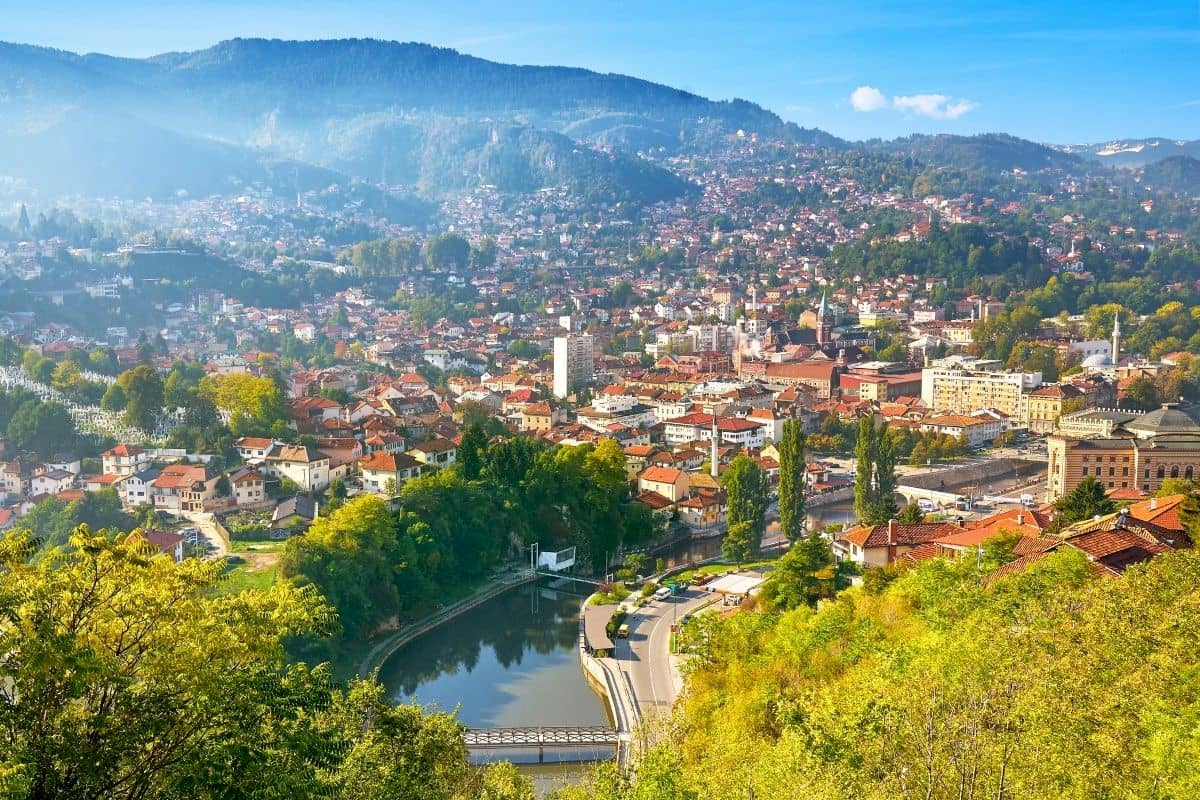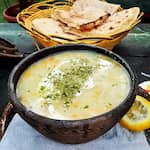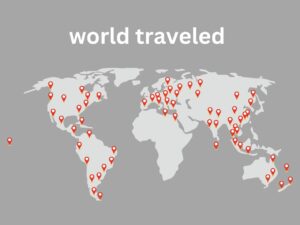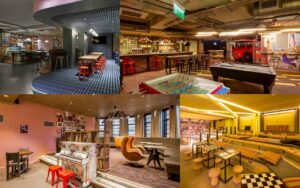Normally Brazilians know little about Eastern Europe and especially the Balkan countries
Located in the heart of the Balkans, Sarajevo is the capital and largest city of Bosnia and Herzegovina, playing a crucial role in the region’s history.
Sarajevo is a beautiful, cultural city and great for enjoying the calm of the city.
In addition, of course, knowing its rich history, even if some of it involved many wars and pain.
Sarajevo is where east meets west.
See my trip to Sarajevo.
A little history of Sarajevo:
Sarajevo dates back to the time of the Ottoman Empire, when it was founded in the 15th century. For centuries, the city flourished as a cultural and commercial center, characterized by its ethnic and religious diversity.
However, Sarajevo’s history is also full of challenges and tragedies. One of the most striking events occurred in 1914, when Archduke Franz Ferdinand of Austria was assassinated in the city, triggering the outbreak of the First World War. This tragic episode left an indelible mark on Sarajevo’s history, transforming it into a focal point for crucial events of the 20th century.
During World War II, Sarajevo witnessed Nazi occupation and local resistance. Subsequently, the city became part of socialist Yugoslavia, led by Tito. However, the dissolution of Yugoslavia in the 1980s and 1990s brought with it a series of ethnic conflicts, culminating in the brutal Bosnian War (1992-1995).
Sarajevo suffered enormously during the nearly four-year siege during the war, one of the longest in modern history. The city has been bombed and citizens face extremely difficult living conditions. The resilient spirit of Sarajevo’s people, however, was evident, and the city eventually emerged from the conflict with a renewed determination for peace and reconstruction.
Today, Sarajevo is a vibrant city that incorporates its complex history into its urban landscape. Visitors can explore the architectural remnants of Ottoman rule, the visible scars of recent war, and the renewal efforts that continue to shape the city’s destiny. The history of Sarajevo is a testimony to the resilience of the people, the ability to overcome adversity and the continuous search for peaceful coexistence amidst diversity.
If you want to see more about Sarajevo.
Main attractions
1. Take a free walking tour
In my opinion, the best way to discover a new destination is to go on walking tours.
Today major cities have free walking tours which are an economical way to see the main sights, learn about the destination, meet new people.
They’re a quick and easy way to get an overview of a city, which helps you plan the rest of your trip.
Search the internet, and you will find some, I use freetour.com and it was great.
If you like it, leave a tip for the guide.
2. Wander the streets of Bascarsija.
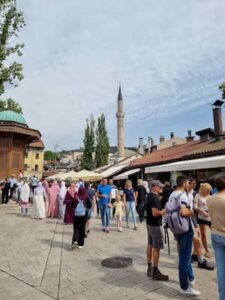
Baščaršija, whose name means “bazaar” in Turkish, is the historic heart of Sarajevo, was founded in the 15th century by the Ottomans and became the pulsating center of Sarajevo’s commercial and social life.
3. Find Sebilj Source
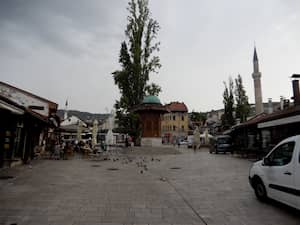 Located in the Baščaršija neighborhood, Sebilj, an ornate public fountain built in the 17th century. It is an iconic location, where people historically met to socialize and collect drinking water. Sebilj represents not only an architectural landmark, but also a symbol of the community life that characterizes Sarajevo.
Located in the Baščaršija neighborhood, Sebilj, an ornate public fountain built in the 17th century. It is an iconic location, where people historically met to socialize and collect drinking water. Sebilj represents not only an architectural landmark, but also a symbol of the community life that characterizes Sarajevo.
4. Culture Meeting Point

Although it’s just a drawing on the sidewalk, Sarajevo is known as a city where east meets west.
This historic landmark is marked on the land where the modern Ferhadija shopping street meets Sarači, a shopping street since 1531, when the Ottoman governor, Gazi Husrev Bey, ordered the construction of 60 shops.
5. Sacred Heart Cathedral
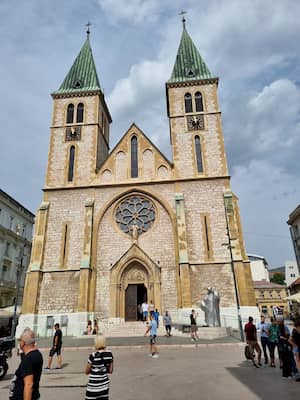
Sacred Heart Cathedral is the largest cathedral in Sarajevo built during Austro-Hungarian rule.
It has a statue of Pope John Paul II, who visited it in 1997, after the war, to preach the message of peace and tolerance.
6. Latin Bridge, where the first world war began
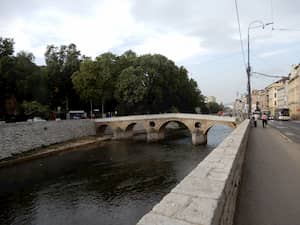
The Latin Bridge is one of the most iconic and historically significant bridges in Sarajevo. Situated over the Miljacka River, this stone bridge represents a link between the past and the present.
The Bridge gained worldwide notoriety due to the assassination of Archduke Franz Ferdinand of Austria and his wife, Sofia, on June 28, 1914. This event triggered a chain reaction of political and military actions, leading to the outbreak of the First World War.
7. Stroll along Ferhadija street
 Ferhadija Street is the main shopping street in Sarajevo. Grand Austrian mansions house commercial shops, while small stalls sell local snacks and pomegranate juice. There are some great restaurants in this part of town.
Ferhadija Street is the main shopping street in Sarajevo. Grand Austrian mansions house commercial shops, while small stalls sell local snacks and pomegranate juice. There are some great restaurants in this part of town.
8. Visit Mount Trebević
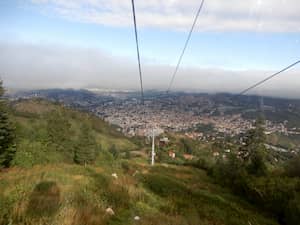
Today, Mount Trebević is a popular destination for locals and visitors alike, offering a peaceful escape from the hustle and bustle of the city. It is a perfect location for hiking, cycling and skiing during the winter months.
I did several trails, including one of the most famous, which is the abandoned bobsleigh track from the 1984 Olympics.
9. Tunnel of Hope
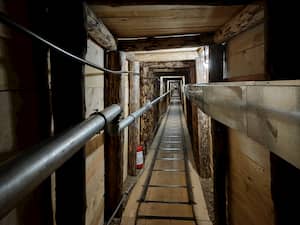
Although it is further from the center, the Tunnel of Hope is worth visiting. When the capital was surrounded by the Bosnian Serb army and isolated from the rest of the world, it was the only escape route, as well as a means of smuggling food and weapons.
As it is difficult to get there by public transport, I suggest going as part of a tour or taking a taxi.
10. Visit City Hall
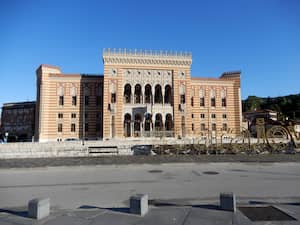
Vijećnica was built in the Neo-Moorish style, an architectural expression that incorporates elements of Islamic and Moorish architecture. Designed by Czech architect Karel Parik, the building was completed in 1896, during the Austro-Hungarian period.
During the siege of Sarajevo during the Bosnian War (1992-1995), the town hall was seriously damaged by a fire that consumed much of the collection of the National Library, which was housed in the building at the time.
11. stroll in Veliki Park
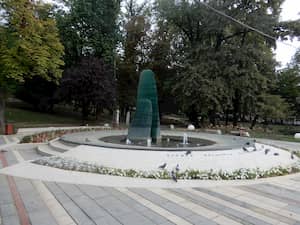
Sarajevo doesn’t have many parks, the biggest being Veliki Park (Great Park) next to Maršala Tita street.
As it is close to the center I went to visit and enjoy the green space.
There isn’t much to see other than a stroll through the tree-lined streets.
At the entrance there is a monument dedicated to the Sons of Sarajevo who died during the siege and a statue of Srebrenica’s father who called his son, saying that the Serbs will not harm them
However, Srebrenica is sadly known for the massacre of thousands of Bosnian Muslims carried out by Bosnian Serb forces in July 1995.
12 Take a walk along the Miljacka River
 The Miljacka River looks more like a small river, with little water, but it runs through the city and you can see many unusual buildings. In addition to, of course, the various bridges
The Miljacka River looks more like a small river, with little water, but it runs through the city and you can see many unusual buildings. In addition to, of course, the various bridges
13 Day tour from Sarajevo.
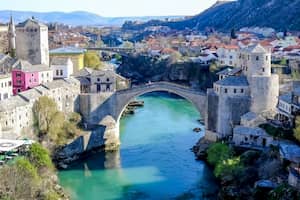
Se tiver um dia sobrando é uma boa oportunidade de visitar outros lugares.
Se o tempo for curto visite Ilidza, Basta uma viagem de bonde elétrico para chegar. O local é famoso por seu lindo parque com alguns hotéis ou vilas antigas e charmosas e montanhas ao redor.
Se tiver um dia inteiro, o mais famoso é Mostar, a cidade icónica conhecida pela antiga ponte otomana suspensa sobre as águas azul-turquesa do rio Neretva,
Você pode combinar a visita a Mostar com outros lugares interessantes próximos: Blagaj, Pocitelj ou Cachoeiras Kravice.
Best time to visit Sarajevo
The best time to visit Sarajevo depends on what you are looking for.
My vision is to always be in a milder climate, lower costs and emptier attractions.
Therefore, the best time to visit Sarajevo is from March to May and from September to November. I visited Sarajevo at the end of September.
These times of year are when the weather is mild and the city is not overcrowded and there is little rain.
Winter (December to February):
If you like winter and snow-related activities, visiting the city during this period could be a good choice.
Sarajevo is covered in snow, creating a magical atmosphere. However, temperatures can be quite low, especially in January
Spring (March to May):
Spring is a pleasant time, temperatures start to rise, the days get longer, and the city comes to life with flowers and lush vegetation. It’s a good time to explore the city on foot and enjoy the parks and outdoor cafes.
Summer (June to August):
Summer is the high season, the days are long and hot, with temperatures that can reach quite high levels. This is a popular time for cultural events, festivals and outdoor activities. However, it can get busier and prices can be much higher.
Autumn (September to November):
Autumn in Sarajevo is marked by mild temperatures and vibrant colors. This is a great time to avoid the high season crowds while still enjoying pleasant weather conditions. The months of October and November can bring cooler temperatures, but are still good for exploring the city.
See my visit to Sarajevo in October.
How to get to Sarajevo.
The main ways to get to Sarajevo are:
Plane:
Sarajevo International Airport (SJJ): This is the main airport serving Sarajevo. It receives international flights and some regional connections. From the airport, you can take a taxi, transfer service or use public transport to reach the city center.
Bus:
Sarajevo International Bus Station:
Sarajevo is connected to several European cities via bus services. Sarajevo’s international bus station is well equipped, and many bus companies offer direct connections to different cities in Europe.
I used this one for my trip to Croatia.
Sarajevo East Bus Station
Some Balkan cities leave from this station which is 8 km from the center, I arrived via it from Belgrade.
Car:
Sarajevo is accessible by road and can be reached by car from several European cities. Road conditions may vary and it is advisable to check conditions before travelling.
Train:
The rail system in the region may not be as extensive as in other parts of Europe, but there are train services that connect Sarajevo to some neighboring cities and countries. However, for longer trips, plane or bus are generally more practical options.
Getting around Sarajevo.
For me, the best ways to get around are always on foot and public transport.
That’s why I always stay close to attractions and/or public transportation.
Sarajevo can be done on foot, as almost everything is very close.
Public transport is also not the best.
On foot:
On foot it is possible to admire the life of the city’s population while seeing its main attractions. Many of the city’s main tourist attractions are within walking distance of each other. When you need to go further afield, there is a very efficient metro and bus network.
Car:
You only need a car if you are arriving with one, as everything in the city is done on foot.
Public transportation:
By bus, tram and trolleybus: for some places like the National Museum and the History Museum, you can take tram 3 heading to Ilidža.
It costs approximately US$1.00, I haven’t used it, so I don’t have a clear idea of how it works.
By taxi:
Taking a taxi is very easy if you are in the center, but be careful, there are many who take advantage of the situation to charge more.
When I arrived at the station, the taxi charged me EU 20.00 to the center and it is only 8 KM.
After a chat it was priced at EU 12.00
Better to check with the locals about the price before taking it.
What is the best neighborhood to stay in Sarajevo
I always keep the location in mind when choosing where to stay, as it influences the way I get to know the place.
For me the location must have it.
- Being close to public transport.
- Being within walking distance of the main attractions.
- Easy to get to and from, if possible, by walking.
- Better transportation cost.
- Be no more than 3 km from the city center and/or attractions.
However, in Sarajevo, all the main attractions are very close to the center.
So staying anywhere near the center is ideal.
Where to stay.
Over time, the way we travel and stay changes.
I’ve been to 5-star hotels and hostels with shared rooms for up to 10 people.
Today I have been looking for a new way to stay that is a mix of Airbnb and hotels.
They are “apartments”, small or not with the infrastructure to cook, so in addition to having better privacy, they save on the cost of meals and I am not paying for infrastructure that I do not use, such as a swimming pool, gym, etc.
They are classified between economic and medium, but with very significant savings.
I explain better here.
Economic:
Hostel Franz Ferdinand
Hostel Franz Ferdinand is located in the city center, just 10 m from the main promenade and 100 m from Bascarsija and other attractive and important tourist spots in Sarajevo
Average:
KONAK MALI
Konak Mali is a very simple, air-conditioned apartment featuring a seating area, a kitchen with a fridge and a flat-screen TV.
I stayed at the FestivalStreet Apartment, right in the center, with all the amenities of an apartment.
Plus, I saved a lot on food.
LUX:
Hotel Europa
Hotel Europa is one of the most traditional 5-star hotels, with over 130 years of tradition, centrally located in Sarajevo.
Gastronomy in Sarajevo
Sarajevo’s cuisine is both an experience of flavors and a journey through the city’s history and cultural diversity.
Some of the Main Dishes.
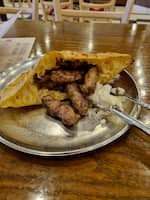
Cevapi:
This is a well-known Bosnian dish consisting of small rolls of ground meat, usually beef, lamb or a mixture of both. Cevapi are often served with somun, a traditional flatbread, and chopped onion.
Burek:
An Ottoman specialty widely enjoyed in Bosnia and Herzegovina, burek is a puff pastry filled with minced meat, cheese, potatoes or spinach. It’s a popular option for breakfast or as a snack throughout the day.

Baklava:
A sweet, rich dessert made with thin layers of puff pastry, walnuts or almonds, and sugar syrup. Baklava is a delicacy enjoyed in many cultures, including Bosnia.
Begova čorba:
This soup is a unique Sarajevo creation, dating back to the days of the Ottoman Empire. Begova čorba is a thick soup made with chicken meat, vegetables, and a mixture of spices, often enriched with roux (a mixture of flour and fat).
Tipical drinks:
Turkish Coffee:
The Ottoman coffee tradition is deeply rooted in Sarajevo. The coffee is prepared in a special way, ground very finely and served in small cups. It is often accompanied by a piece of rahat lokum, a type of Turkish sweet.
Rakija:
This is a distilled alcoholic drink common in many Balkan countries. It can be made from different fruits, such as plums, pears or apples. Rakija is often consumed as an aperitif or digestif and is an integral part of celebrations and social gatherings.
Boza:
This is a sweet, thick traditional drink made from fermenting grains, usually corn or wheat. Boza is often eaten during winter and is prized for its unique flavor and dense texture. It is a non-alcoholic drink, suitable for all ages.
Salep:
A warm, comforting drink made from orchid tubers. Salep is an Ottoman tradition and is especially enjoyed during the colder months. It is often prepared with milk and seasoned with cinnamon.
2 day itinerary in Sarajevo
In my experience, any city can be well visited in two full days.
Depending on the type of visit you want to make.
I am doing the visits on this itinerary, not counting the paid entrance fees, as there are usually a lot of queues and it depends a lot on the style of your trip.
For those who really like museums, climbing monuments, etc., you should add another day or reduce the number of attractions to be visited.
However, in Sarajevo it is possible to do everything in two days, so everything is very close.
First Day: Visit the city’s attractions
As there are not many attractions and they are very close, I left it a little closer to 10 am.
The first point was the Latin Bridge, where the First World War began.
Following the Miljacka River towards Sarajevo City Hall, passing several mansions on the riverbank.
After the visit, continue to a small dam on the river, exploring the place.
Cross the River using one of the bridges and pass through the square where there is #SARAJEVO in front of the city hall.
Going down the river, you pass the Latin bridge and soon find Mejdan park with its music pavilion and then pass a green and yellow building with strange architecture and the Ashkenazi Synagogue.
Continuing down the river you reach the Festina Bridge in front of the Academy of Fine Arts.
A little further and you reach the Skenderija Bridge, which is a modern bridge located near the Skenderija Convention Center. Built to connect the banks of the Miljacka River, this bridge is characterized by its contemporary design.
Cross the bridge and continue for about 300 meters to Ali Pasha’s Mosque.
Now turning towards the center, you pass through Veliki Park, where you can rest and enjoy some of the city’s greenery.
Another 400 meters and you reach Sarajevo’s Eternal Flame and the city center.
Taking the street to the right you soon reach the Cathedral Church of the Nativity of the Theotokos.
We are in the city center and the restaurants and shops are in this region.
I went to the Baščaršija neighborhood, which is about 600 meters away, as it has the best typical food restaurants in the city.
On recommendation, I went to the Ćevabdžinica Petica Ferhatović restaurant to eat Cevapi. It was great.
I spent the rest of the afternoon wandering the streets of the neighborhood, enjoying the sweets, ice cream, and tourist attractions.
At night:
The center creates new life at night, cafes and restaurants fill up in addition to the streets full of tourists and locals.
Later, those who like nightclubs and noisy bars have a huge number of options.
Second day: Mount Trebević
Although the weather forecast was not good for the afternoon, a beautiful day dawned, and I took the cable car to climb Mount Trebevic.
The intention was to go down the trail if the weather helped, but as soon as we went up, the weather was getting worse.
The climb up the cable car is very easy and quick (10 minutes). It costs US$10.00.
I downloaded the SOAR app, with all the trails near Sarajevo, so it’s safer.
I started at the abandoned bobsled track, went halfway and using the map I took the other trails, it was a very peaceful walk, there are a lot of ups and downs, but I’m used to it.
For those who are not there, it is better to take a walk at the top and just take the abandoned trail when going down.
I was lucky that the weather improved, and I was able to hike more trails, but the weather turned bad, and I was able to take the cable car down before the rain.
It was just time to get to the restaurant, and it rained all afternoon.
How much does it cost?
3 styles and their costs.
Backpacker:
Stayed in hostels using shared dormitories, eating your own food and/or cheap local restaurants, using local transport, exploring the city on foot and taking tours for free or cheaper.
Daily spending: from US$ 30.00 to 50.00 per day
Intermediary:
Stay in hostels/budget hotels in private rooms, eat in a medium-sized restaurant, go to the main paid attractions, use some taxis and Uber.
Daily spending: US$60.00 to 100.00 USD per day.
Luxurious:
Stayed in the best hotels, go to all the attractions, hire more sophisticated packages such as use of a helicopter, etc.
Daily spend: US$140.00 and above per day.
